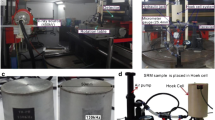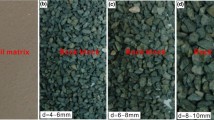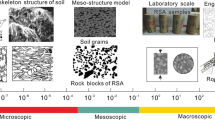Abstract
Real-time ultrasonic experiments were conducted to investigate the mechanical responses of block-in-matrix soil (bimsoil) samples under triaxial deformation. Although the mechanical behaviors of bimrocks and bimsoils have been widely studied, the rock-soil (block-matrix) interface cracking, rock-soil interaction, block occlusion, and interlocking effects during triaxial deformation are still incompletely understood. This paper aims to investigate the effect of confining pressure and block proportion on ultrasonic and mechanical properties of bimsoils using ultrasonic pulse velocity (UPV). Conventional compaction soil testing was adapted to produce cylindrical bimsoil samples of different rock block percentages (RBP) with various hammer counts, to ensure roughly the same compactness of soil matrix. The experimental results show that UPV reflects the complex mechanical behavior of bimosils during deformation. UPV measurements became more variable as samples deformed at the pre-peak and post-peak stages. It is suggested that the UPV is affected not only by stress level but also the meso-structures that develop during failure in bimsoils. Observation of macroscopic fracture morphology combined with image analysis of mesoscopic computed tomography (CT) scans reveals that multiple localized tortuous bands form during deformation due to the presence of rock blocks in bimsoils. The changes of UPV are mainly attributed to the interactions of soil matrix and rock block. The post-test CT images further confirm this result.
















Similar content being viewed by others
References
Afifipour M, Moarefvand P (2014) Failure patterns of geomaterials with block-in-matrix texture: experimental and numerical evaluation. Arab J Geosci 7:2781–2792
Akkaya Y, Voigt T, Subramaniam KV (2003) Nondestructive measurement of concrete strength gain by an ultrasonic wave reflection method. Mater Struct 36(8):507–514
Akram MS (2010) Physical and numerical investigation of conglomeratic rocks. Ph.D. thesis. Univ New South Wales, Sydney, Australia
Bayram E, Tekin Y, Gokhan K (2014) Strength and ultrasonic properties of cemented paste backfill. Ultrasonics 54:195–204
Button E, Riedmueller G, Schubert W, Klima K, Medley E (2004) Tunnelling in tectonic melanges-accommodating the impacts of geomechanical complexities and anisotropic rock mass fabrics. Bull Eng Geol Environ 63(2):109–117. https://doi.org/10.1007/s10064-003-0220-7
Cen D, Huang D, Ren F (2017) Shear deformation and strength of the interphase between the soil–rock mixture and the benched bedrock slope surface. Acta Geotech 12(2):391–413
Coli N, Berry P, Boldini D (2011) In situ non-conventional shear tests for the mechanical characterisation of a bimrock. Int J Rock Mech Min 48:95–102
Donaghe RT, Torrey VH (1994) Proposed new standard test method for laboratory compaction testing of soil-rock mixtures using standard effort. Geotech Test J 3:387–392
Du YN, Xu PF, Liang SQ (2018) Microtremor survey of soil-rock mixture landslides : an example of Baidian township, Hengyang City. Chin J Geophys Chin Ed 61(4):1596–1604
Hartmut K (2001) Measuring and modeling of P- and S-wave velocities on crustal rocks: a key for the interpretation of seismic reflection and refraction data. Int J Geo 9:1–10
Kahraman S (2002) Estimating the direct P-wave velocity value of intact rock from indirect laboratory measurements. Int J Rock Mech Min 39(1):101–104
Kahraman S, Alber M, Fener M, Gunaydin O (2015) An assessment on the indirect determination of the volumetric block proportion of Misis fault breccia (Adana, Turkey). Bull Eng Geol Environ 74(3):899–907
Kalender A, Sonmez H, Medley E, Tunusluoglu C, Kasapoglu KE (2014) An approach to predicting the overall strengths of unwelded bimrocks and bimsoils. Eng Geol 183:65–79
Kem H, Tubia JM (1993) Pressure and temperature dependence of P-and S-wave velocities, seismic anisotropy of sheared rocks form the Sierra Alpujata massif (Ronda peridotites, southern Spain). Ear Planet Sci Lett 119(23):191–205
Kim C, Smell C, Medley E (2004) Shear strength of franciscan complex melange as calculated from back analysis of a landslide. In: Proceedings of the Fifth International Conference on Case Histories in Geotechnical Engineering. New York, pp 13–17
Lindquist ES (1994) The strength and deformation properties of melange. Ph.D. Thesis, Department of Civil Engineering, University of California. Berkeley
Lindquist ES, Goodman RE (1994) The strength and deformation properties of a physical model mélange. Proc. 1st north American rock Mech. Symp., Austin, Texas, pp 843–850
Mahdevari S, Maarefvand P (2017) Applying ultrasonic waves to evaluate the volumetric block proportion of bimrocks. Arab J Geosci 10(9):204
Medley EW (1994) The engineering characterization of melanges and similar block-in-matrix rocks (bimrocks). Ph.D. Dissertation University of California at Berkeley
Medley EW, Zekkos D (2011) Geopractitioner approaches to working with antisocial Mélanges. Invited paper. [Paper]. In: Wakabayashi J, Dilek Y (eds) Mélanges: Processes of Formation and Societal Significance, vol 480. Geological Society of America Special, pp 261–277
MWRPRC (Ministry of Water Resources of the People’s Republic of China) (1999) GB/T 50123–1999: standard for soil test method. MWRPRC, Beijing
Napoli ML, Barbero M, Ravera E, Scavia C (2018) A stochastic approach to slope stability analysis in bimrocks. Int J Rock Mech Min Sci 101:41–49
Priyadarshee A, Kumar A, Gupta D, Pushkarna P (2018) Compaction and strength behavior of Tire crumbles–Fly ash mixed with clay. J Mater Civ Eng 30(4):04018033
Slatalla N, Alber M, Kahraman S (2010) Analyses of acoustic emission response of a fault breccia in uniaxial deformation. Bull Eng Geol Environ 69(3):455–463
Sonmez H, Tuncay E, Gokceoglu C (2004) Models to predict the uniaxial compressive strength and the modulus of elasticity for Ankara agglomerate. Int J Rock Mech Min Sci 41(5):717–729
Sonmez H, Gokceoglu C, Medley E, Tuncay E, Nefeslioglu HA (2006) Estimating the uniaxial compressive strength of a volcanic bimrock. Int J Rock Mech Min Sci 43:554–561
Su H, Hu J, Tong J, Wen Z (2012) Rate effect on mechanical properties of hydraulic concrete flexural-tensile specimens under low loading rates using acoustic emission technique. Ultrasonics 52(7):890–904
Tsesarsky M, Hazan M, Gal E (2016) Estimating the elastic moduli and isotropy of block in matrix (bim) rocks by computational homogenization. Eng Geol 200:58–65
Tsiambaos G (2010) Engineering Geological Behaviour of Heterogeneous and Chaotic Rock Masses. In: Proceedings of the 12th International Congress. Bulletin of the Geological Society of Greece, Patras. https://doi.org/10.12681/bgsg.11173
Wang Y, Li X (2015) Experimental study on cracking damage characteristics of a soil and rock mixture by UPV testing. Bull Eng Geol Environ 74(3):775–788
Wang Y, Li X, Zhang B, Wu YF (2014) Meso-damage cracking characteristics analysis for rock and soil aggregate with CT test. SCIENCE CHINA Technol Sci 57(7):1361–1371
Wang Y, Li X, Hu RL, Li SD, Wang JY (2015) Experimental study of the ultrasonic and mechanical properties of SRM under compressive loading. Environ Earth Sci 74(6):5023–5037
Wang Y, Li X, Zheng B, He JM, Li SD (2016) Macro–meso failure mechanism of soil–rock mixture at medium strain rates. Géotechnique Lett 6:235–243
Wang Y, Li CH, Wei XM, Hou ZQ (2017a) Laboratory investigation of the effect of slenderness effect on the non-Darcy groundwater flow characteristics in Bimsoils. Water 9(9):676
Wang Y, Li CH, Wei XM (2017b) Investigation of the macro–meso failure mechanism for soil–rock mixture under splitting loading using real-time ultrasonic measurement and 3-D laser scanning. Eur J Environ Civ Eng. https://doi.org/10.1080/19648189.2017.1374882
Wang Y, Li CH, Hu YZ (2018) Use of X-ray computed tomography to investigate the effect of rock blocks on meso-structural changes in soil-rock mixture under triaxial deformation. Constr Build Mater 164:386–399
Yamamoto Y, Springman SM (2017) Three-and four-point bending tests on artificial frozen soil samples at temperatures close to 0° C. Cold Reg Sci Technol 134:20–32
Yasar E, Erdogan Y (2004) Correlating sound velocity with density, compressive strength and young modulus of carbonate rocks. Int J Rock Mech Min 41(5):871–875
Yongbo F, Adewuyi OI, Chun F (2015) Strength characteristics of soil rock mixture under equal stress and cyclic loading conditions. Geosyst Eng 18(1):73–77
Zhang LJ (2016) Study on time-lagged fracture characteristic of brittle rock under high stress conditino. Ph.D. Dissertation China University of Geoscience in Wuhan
Zhang S, Tang H, Zhan H, Lei G, Cheng H (2015) Investigation of scale effect of numerical unconfined compression strengths of virtual colluvial–deluvial soil–rock mixture. Int J Rock Mech Min Sci 77:208–219
Zhang ZL, Xu WJ, Xia W, Zhang HY (2016) Large-scale in-situ test for mechanical characterization of soil–rock mixture used in an embankment dam. Int J Rock Mech Min Sci 86:317–322
Acknowledgements
The authors would like to thank the editors and the anonymous reviewers for their helpful and constructive comments.
Funding
This work was supported by the National key technologies Research & Development program (2017YFC0804103, 2018YFC0808402, 2018YFC0604601), the Fundamental Research Funds for the Central Universities (2302017FRF-TP-17-027A1), the National Natural Science Foundation of China (Grants Nos. 41502294), and the State Key Laboratory for GeoMechanics and Deep Underground Engineering, China University of Mining & Technology (SKLGDUEK1824),
Author information
Authors and Affiliations
Corresponding author
Ethics declarations
Conflict of interest
The authors declare that they have no conflict of interest.
Rights and permissions
About this article
Cite this article
Wang, Y., Li, C.H. & Hou, Z.Q. Mechanical behaviors of bimsoils during triaxial deformation revealed using real-time ultrasonic detection and post-test CT image analysis. Arab J Geosci 12, 10 (2019). https://doi.org/10.1007/s12517-018-4179-x
Received:
Accepted:
Published:
DOI: https://doi.org/10.1007/s12517-018-4179-x




